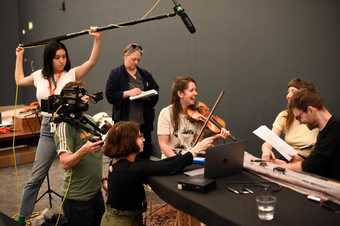“Spirits from another world are trying to contact us through our television sets.
"According to a report out this week, many people have reported hearing voices and seeing strange images on their TV sets which are not altogether connected with the scheduled programming.”
Susan Hiller created her video installation Belshazzar’s Feast after reading newspaper coverage about people who had witnessed ghostly apparitions and mysterious messages on their TV sets after broadcasting ended at midnight. The press speculated about transmissions from UFOs or other supernatural events, but Hiller recognised what all these explanations refused to acknowledge, which was the innate power of human imagination. She realised that gazing at a television could spark states of reverie and fantasy, just as staring into a fire had done in ancient times. The title of her work, Belshazzar’s Feast, came from the Biblical story of King Belshazzar trying to decipher a divine message that suddenly appeared on his wall.
“What I felt was that people watched television not for the scheduled broadcasting, but for the haptic pleasure they get of the blobs of light moving across the screen, which is a kind of primeval thing that our ancestors would have enjoyed in caves.”
Hiller made adjustments to Belshazzar’s Feast over her life and different versions have sometimes existed at the same time. But when the life of an artist ends, how do their artworks continue to live?
Let’s rewind to before Belshazzar’s Feast’s conception. Susan Hiller was born in 1940 and grew up in Ohio and Florida. Her fascination with different places and cultures inspired her to study anthropology. Although she later abandoned her doctorate degree to become an artist in England, she channelled her interest in culture, language, the subconscious and the supernatural into her art.
“In all of my work, I’m attempting to erase or erode the supposed boundary between dream life and waking life. Because what I do in all of my work is pull out for scrutiny those images or ideas which are visual, visible, but are rendered invisible, and therefore marginalised.”
Susan always said that all of her work was about aspects of culture that were marginalised or overlooked or ignored, and she always began with some sort of cultural artefact to explore some aspect of ridiculed or overlooked culture.
Hiller often made changes to Belshazzar’s Feast each time it was exhibited. “By moving my own works into another state of being I allow them to participate in life, instead of curating the work as though it were entombed in a museum,” she once said.
At Gimpel Fils gallery in 1984, she placed photographic images and writing on the wall behind a freestanding video monitor. She called this version Belshazzar’s Feast, The Writing on Your Wall.
Tate bought the artwork later that year. When Hiller displayed it at the museum, she embedded the video monitor into a fake wall like a fireplace and placed wallpaper and photographic images around it. She later described this version as a ‘maquette’, or draft model.
Although Belshazzar’s Feast, The Writing on Your Wall was sold to Tate as a unique work of art, it was not unusual at the time for artists to retain the rights to their own ‘artist’s proof’ version of video installations. This allowed Hiller to display Belshazzar’s Feast independent of Tate's version.
1986 saw two new versions. One was shown at the Institute of Contemporary Art in London and is now known as the ‘Campfire’ version.
In the other version, British broadcasters Channel 4 showed the film at midnight across the country. Viewers were told that the scheduled programme had ended for the day but a few seconds later, Hiller’s video began.
Susan loved that because it was returning this work of it was about - television. It was returning it to the medium of television. And her work was coming into domestic spaces all across the country. And that's what many people, including many people from who later on seemed to come up to. Susan in the art world say it was like the first experience of art outside the gallery. They were sitting at home late one night and this amazing thing came on and they were just sort of blown away"
The Channel 4 broadcast inspired Hiller to design her own living room setting for Belshazzar’s Feast. When she exhibited the artwork in different countries, she would often design the living room’s style to reflect local tastes and cultures.
In 2002, Hiller worked with Tate to develop the ‘Full’ version of Belshazzar’s Feast, The Writing on Your Wall, which incorporated living room furniture and lighting. The museum version evolved to take on a stable form, while the artist's version of Belshazzar's Feast had the potential to keep changing.
In 2015, Hiller created a new iteration at Lisson Gallery, called the ‘Bonfire’ version for its tower of video monitors.
Hiller died in 2019 but Belshazzar’s Feast lives on. The question remains: how will the artwork continue to live without the artist? Can a museum preserve their version, unchanged, for the future, or will it keep evolving as its materials age, such as when the wallpaper needs replacing, or when the TV set becomes too old? What will the next stage of Belshazzar’s Feast, The Writing on Your Wall’s life look like?




